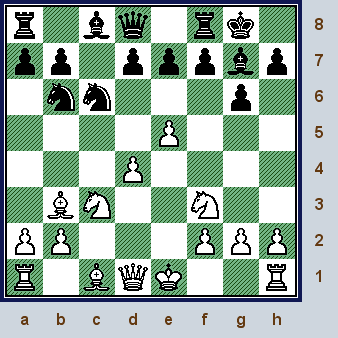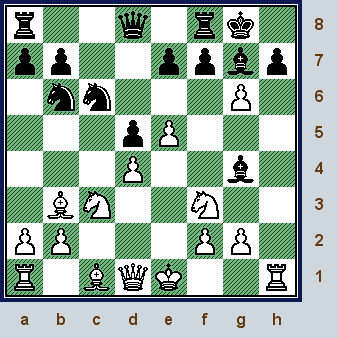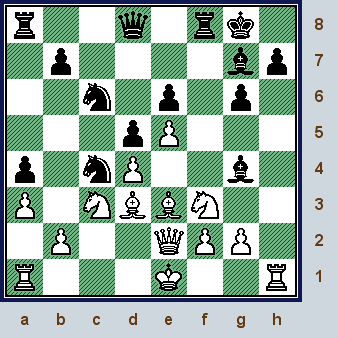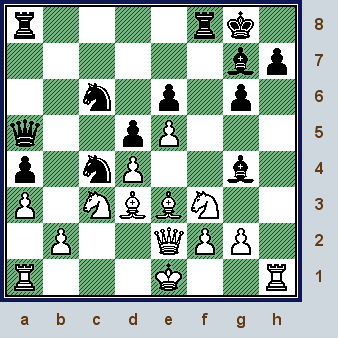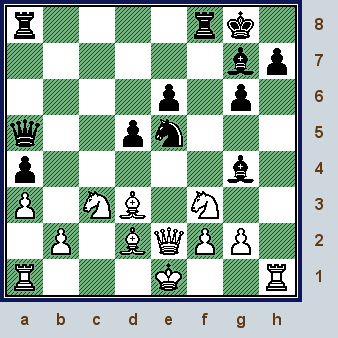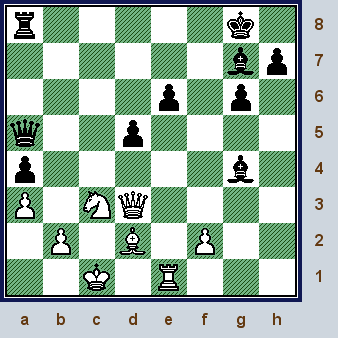All
the |
(Navigation bar
directly below.)
*******
© A.J. Goldsby, 2015.
(All rights reserved.)
****************
Click HERE
to see my
Chess Items.
****************
****************
Buy a book
from Amazon.com
(And help me out as well!)
****************
Click HERE
...
to see a list of the businesses that help to sponsor all of
my chess efforts.
CG
- "Problem of the Day"
(Sunday / September 6th,
2009.)
Click HERE to see an explanation of the symbols that I commonly use when I annotate any chess game.
Click HERE to replay this game ... on another server.
NOTE: This is a pretty good game between two GM's. However, White's play is much less than stellar, nonetheless, I believe that nearly every chess player could learn something by studying this game. There is a fairly good review of the opening, if you are trying to learn this opening - from either side - then there is (more than) enough information here to get you started. (Lots of good links here, as well.)
This game is also a nearly perfect pursuit of the initiative by Black. (Good tactics!)
-
- I did not want to annotate every single possibility at every single move ... and this web page is NOT an effort to do this!
I analyze what I believe to be the most relevant continuations ... and there is a link to a page, (above, at the top of this page);
where there will be more analysis and discussion of this game ... if you are interested in more, more, more!!! -
- Another reason that I annotated this game was that - although the Alapin Sicilian has been very popular, and I have faced it
many times in tournaments - I had not annotated many games in this system. Therefore, I felt it was an opportunity to teach.
One of my prime motivations today is to help anyone - especially young persons - who may not have many chess books.
Perhaps the only way that they can learn about chess is if they have access to a computer and the Internet. -
- I also tried to link ALL the games referenced to on this page back to the CG website. However, it was not possible to do this
for all the games mentioned here. (Unfortunately, not all of these games were carried on the "ChessGames" website.) Please
note that both of the games that were not carried by CG ... that I have already submitted both of these games to them. If -
and when - these games become available for replay, then I will link to them at that time.
GM Eduard Rozentalis
(2600) - GM
Viktor Bologan (2540);
|
|
|
[A.J. Goldsby I]
The "Chess Games" daily puzzle or the "Problem of The Day," (POTD) ... for Sunday; September 6th, 2009.
Black to play his nineteenth move. (19 ... '?').
See this page for another game in this line ... ... ... (explore all the links on that page thoroughly!).
1.e4 c5;
2.c3, (The Alapin.)
This slow form of the Sicilian has found many advocates over the years, including
a few high-level GM's.
This opening was very popular during the 1970's and the 1980's. It also received a boost when Deep Blue used it to defeat Garry Kasparov in Game #1 of their 1996 ACM Chess Challenge Match. {Replay these games.} (See {also} my website ... that is completely devoted to the chess games of man versus the machines. http://www.angelfire.com/fl5/human_fan02/index.html.)
PLEASE NOTE:
While this position is currently part of the Sicilian
Opening, play could easily transpose
to other openings. For example, after 2...d5; 3.e5, we could quickly cross over
to the Advance Variation of the French. (This is just one example.)
[ Normal is: 2.Nf3,
(Which
is the Open Sicilian. Its called an open Sicilian,
because White usually plays Nf3 followed by d2-d4.
After the pawns get swapped on the
d4-square, then the game is more open ... as compared to a Closed
Sicilian.)
In the Closed Sicilian, White generally
avoids playing d2-d4 in the first five-to-ten moves. See MCO-15 for more
details.). ]
2...Nf6;
(The four basic
Opening Principles.)
Black develops his Knight.
Originally, (the 1970's?); this move was condemned as premature, today it is one of Black's most trusted replies.
[
Another alternative is: 2...d5;
3.exd5 Qxd5; 4.d4 Nf6; 5.Nf3 e6; 6.Bd3 Be7; 7.0-0 0-0;
8.Be3 cxd4; 9.cxd4 Nc6; 10.Nc3,
"+/-" 10...Qd6; "<=>"
White has a slight edge in this
position, however Black is thought to have fairly good chances here.
A good - and relatively recent - contest
would be the following encounter:
GM Sune Berg Hansen (2555) - GM Vladimir Chuchelov (2534);
National Team / Bundesliga, 0506
/ Germany, (R#9.4) / 29,01,2006.
{White won, 1-0 in 39 moves.}
[ See MCO-15, page # 352; column # 04, and notes q-u. ] ]
3.e5 Nd5;
4.Nf3, (development)
Today, this is one of White's favorite responses at the master-level, although
White has many playable options here.
[ A different path for White was: 4.d4 cxd4;
5.Nf3 Nc6; 6.Bc4 Nb6; 7.Bb3 d5;
The most reliable move for Black.
(After RR7...dxc3!?; 8.Nxc3, "+/=" theory holds that white has good compensation in this position.)
8.exd6 Qxd6;
9.0-0 Be6; 10.Na3!?, (hmmm)
A daring, gambit-type approach.
(RR10.Bxe6 Qxe6; 11.Nxd4, "=" )
10...dxc3; 11.Qe2 Bxb3; The end of the column.
12.Nb5 Qb8; 13.axb3 e5; 14.Nbd4 f6; 15.bxc3 Be7; 16.Nf5 0-0; 17.N3h4, "/\" and White had good play.
IM David Howell (2475) - GM Peter K. Wells (2513); / BCF-chT 0506 (4NCL)
/ Birmingham, (R# 4.1); ENG;
20,11,2005. {Black won a long,
tough struggle, 0-1 in over 50 moves.}
[ See MCO-15, page # 352; column # 01 and all applicable notes, especially note # (j.). ] ]
4...Nc6;
5.Bc4 Nb6; 6.Bb3 g6;
Black fianchetto's his King's Bishop, this aids in putting more pressure on
the White's center, especially the foot soldier on the e5-square.
[ The Fritz "Power Book" (instead)
gives the following continuation:
6...c4!?; 7.Bc2 Qc7; 8.Qe2 g5!?;
9.h3 Bg7; 10.0-0 Nxe5; "~" (Maybe - "=/+")
when Black has good play.
A good - recent game - would be:
GM David Howell (2614) - GM Loek van Wely (2655);
7th Staunton Memorial / London,
ENG; (R#9) / 16,08,2009.
{Black was thoroughly outplayed, 1-0 in 34 total
moves. Replay.}
]
7.d4 cxd4;
8.cxd4 Bg7; 9.Nc3 0-0; {See
the diagram given - below.}
Thus far, both sides have developed reasonably well, perhaps White has the
tiniest bit of an advantage. (more space)
|
|
r1bq1rk1/pp1pppbp/1nn3p1/4P3/3P4/1BN2N2/PP3PPP/R1BQK2R; White to move. (10. '?')
Now - for his tenth move - White would do well to castle. (This is confirmed by the theory of this line, the CB "Power Book" and several strong engines, as well.)
10.h4!?,
(Too aggressive?)
This is a wild move. Initially, it had great success, but Black does well
to ignore White's wing demonstration and simply play to develop and also
control the center. (The "R" formula.)
("R" = The Reinfeld Formula. A {premature} wing attack is usually
best countered by a break in the center. Masters know this principle well,
it is one of the reasons that you usually cannot start a prolonged wing
attack until the center is fixed or locked.)
[ RR >/= 10.0-0 d6; "~" or even equal ("=") ]
10...d5!;
11.h5 Bg4; 12.hxg6?!, (line opening)
{See the diagram given -
below.}
White continues to attack ... however, he is behind in development.
[ >/= 12.h6 Bh8; 13.Rh4, "~" ]
|
|
r2q1rk1/pp2ppbp/1nn3P1/3pP3/3P2b1/1BN2N2/PP3PP1/R1BQK2R Black to play. (12... '?').
Now White was expecting ...hxg6;
I feel certain of this. (Normally, you will generally capture towards the center of the board.)
12...fxg6!;
This opens the f-file and puts a great deal of pressure on the White Knight on f3.
13.Be3
a5!; 14.a3!? e6; 15.Qe2 a4; 16.Bc2
Nc4;
This is good, as was 16...Rc8.
17.Bd3?,
{See the diagram given - below.}
An error ... and a loss of time.
|
|
r2q1rk1/1p4bp/2n1p1p1/3pP3/p1nP2b1/P1NBBN2/1P2QPP1/R3K2R; Black to move. (17... '?').
Now take a look at this position ... what move should Black play here?
[ >/= 17.Bxa4 Qb6; 18.Rh4 h5; "~" ("compensation") ]
(Here ----> the machine's analysis likes
the immediate 17...N/6xP/e5. However, I much prefer Black's move in this game,
nearly ALL of Black's pieces are soon pointing directly at the White King.)
17...b5!;
18.Nxb5!? Qa5+; 19.Nc3[], (Only move, or "box.")
{See the diagram given - below.}
White's last move was completely forced.
[ Of course not: </= 19.Kf1?? Qxb5; "-/+" and Black wins a piece. ]
|
|
r4rk1/6bp/2n1p1p1/q2pP3/p1nP2b1/P1NBBN2/1P2QPP1/R3K2R Black to move. (19... '?')
19...N4xe5!!;
Absolutely brilliant.
In one stroke, all of Black's pieces can now come into play, including the
formerly dormant Black Bishop on g7. Additionally, the Knights on f3 and
c3 now find themselves the victim of unbearable pressure. (multiple pins)
[ Not effective for Black was:
</= 19...Rac8?!; 20.Bxc4 dxc4; 21.Qc2,
"+/="
and the machine shows that White is at least a little better.
]
20.dxe5[],
White had no choice.
[ White's situation after the moves:
</= 20.Qc2? Nxf3+; 21.gxf3 Bxf3; 22.Rh3 e5; "-/+"
would have merited resignation. ]
20...Nxe5;
21.Bd2!?, {See the diagram given, just below.}
Not great, however, everything was losing here for White.
|
|
r4rk1/6bp/4p1p1/q2pn3/p5b1/P1NB1N2/1P1BQPP1/R3K2R; Black to play, (21... '?').
[
Black also does well with:
21.0-0-0 Nxf3; 22.gxf3 Bxf3; 23.Qd2 Rfc8!; 24.Bc2 Rab8; "~"
with a dominating position.
(Fritz's evaluation of this position is that Black is simply winning here.)
]
Now Black really pries open the lines that lead to the White King.
21...Rxf3!; 22.gxf3 Bxf3; 23.Qf1[] Bxh1;
24.0-0-0,
White had to get his King out of the center, before he got mated ...
[
After the continuation of: </= 24.Qxh1? Nxd3+; 25.Kf1
Nxb2; "-/+"
White is even worse off ... than he was in the actual game.
]
24...Bf3; 25.Re1 Nxd3+;
This wins. (The machine prefers the continuation that begins with 25...d4; however, it made no difference.)
26.Qxd3 Bg4; "-/+" {See the diagram given, just below.}
White resigns here. (Black can continue with 27...Bf5; followed by ...Rc8; and ...d4; winning more material.)
White throws in the towel, there was no point in continuing from here. (Fritz shows that Black is winning here. The evaluation after nearly thirty
minutes of machine time is: " - 5.69.")
|
|
r5k1/6bp/4p1p1/q2p4/p5b1/P1NQ4/1P1B1P2/2K1R3; (The game is over, this is the final position.)
A beautiful game by Black, and it is also nearly a miniature as well.
.
For more analysis and a discussion of this game, please see the web page: http://www.chessgames.com/perl/chessgame?gid=1554930 ... there is
always a lively discussion of the game that is featured as the daily problem
for this particular website.
Copyright (c) A.J. Goldsby, 2009. All rights reserved.
0 - 1
An Impala Blog piece ... that mentions this game.
The analysis for this page was prepared with the excellent program, ChessBase 10.0.
The HTML was polished with several different tools and programs, (mostly FP) ... the text was checked for spelling with MS Word.
The diagrams were created with the program, Chess Captor 2.25.
|
Go ... or return ... to my Home Page for this site. Go (or return) ... to my "Annotated Games" (II) Page. Go
... or return ... to my "Best Games" Page. *******
Copyright (c)
LM A.J. Goldsby
I *******
This
page was first generated in: September, 2009.
(Posted
on: Monday; September 7th, 2009.) |
